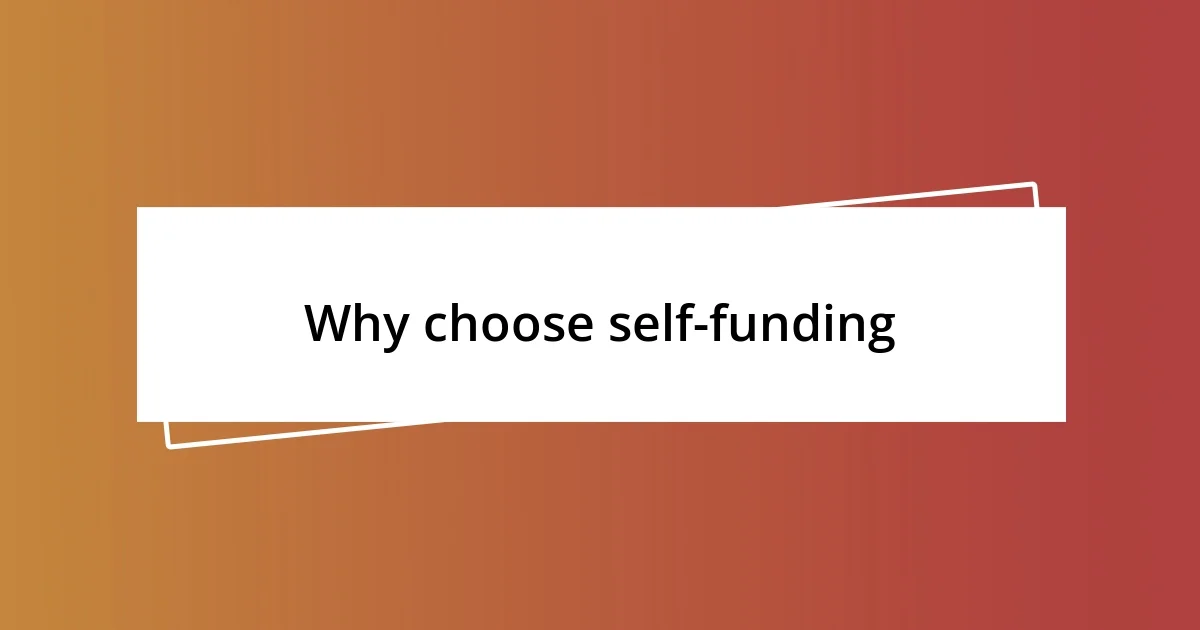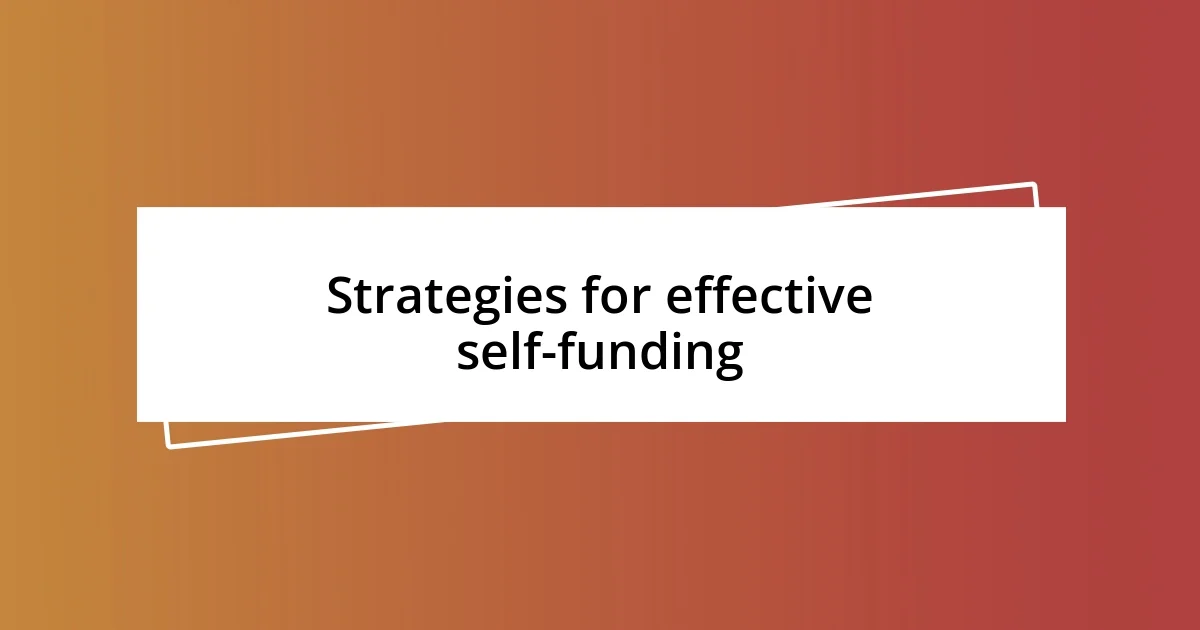Key takeaways:
- Self-funding offers entrepreneurs full control over their projects, fostering creativity while enabling accountability and personal growth.
- Key steps in planning self-funding include assessing finances, setting clear goals, creating a budget, and developing a backup plan to manage uncertainty.
- Future trends indicate a rise in self-funding due to technological advancements and supportive networks, enhancing the experience for aspiring entrepreneurs.

Introduction to self-funding efforts
Self-funding efforts can feel both liberating and daunting. I remember when I first took that leap into self-funding a small business idea. There was an exhilarating rush of independence, but also a nagging fear: would my savings hold up against the realities of entrepreneurship?
What struck me was the balance between risk and reward. With every dollar I invested, I found myself weighing potential outcomes and dreaming of what could be. Have you ever experienced that blend of fear and hope? It’s that emotional rollercoaster that often defines the journey of self-funding.
As I navigated the challenges, I realized that self-funding isn’t just about the financial aspect—it’s also about personal growth and resilience. Each setback taught me something invaluable, reaffirming why I chose this path in the first place. How can we embrace these lessons when facing our own funding decisions?

Why choose self-funding
Choosing to self-fund can be a powerful statement of belief in your vision. When I decided to finance my project independently, it was a pivotal moment that fueled my determination, as I was investing not only money but also my dreams. I distinctly recall how empowering it felt to put my own resources on the line; it made me more accountable and driven.
One major reason people opt for self-funding is the control it gives over the creative process. Unlike relying on external investors, I found that self-funding allowed me to make decisions aligned with my values without external pressure. This independence sparked a wave of creativity, where I could pivot and adapt my plans whenever I saw fit—something I truly cherished during those critical early stages.
Financially, self-funding can often mean less complicated pathways compared to traditional funding routes. I learned early on that while loans and investors come with strings attached, investing my own money provided the freedom to grow at my own pace. The weight of responsibility was there, but it empowered me to cultivate a sustainable model that reflected my aspirations and priorities without outside interference.
| Self-Funding | External Funding |
|---|---|
| Full control over vision and process | Shared decision-making and potential conflicts |
| Greater financial freedom | Repayment obligations and equity sharing |
| Direct personal investment in success | Potential for misaligned interests |

Steps to plan your self-funding
Planning your self-funding approach requires a thoughtful strategy. When I first mapped out my funding journey, I focused on a few key steps that proved invaluable in ensuring I stayed on track. Each stage helped solidify my commitment and reduced my anxiety about the unpredictability of the process.
-
Assess Your Financial Situation: Start by taking a close look at your savings, expenses, and any available resources. I found that understanding what I had on hand gave me a clearer idea of how much I could invest without compromising my overall financial health.
-
Set Clear Goals: Define what you want to achieve with your self-funding. For me, having specific targets helped to keep my motivation alive, especially during challenging times. I could visualize my success, which fueled my daily efforts.
-
Create a Budget and Timeline: Establish a budget that outlines how much you’ll be spending on various aspects of your project and set a timeline for getting your ideas off the ground. The first time I did this, it was eye-opening; I realized that some of my initial plans were overly ambitious, and I needed to adjust accordingly.
-
Develop a Backup Plan: Life is unpredictable, so preparing for uncertainty is essential. I remember when an unexpected expense popped up right after I launched, which was daunting. However, having a backup plan in place eased my worries and allowed me to pivot quickly.
-
Monitor and Adjust: Once you start, regularly review your progress against your budget and goals. I discovered that periodic check-ins not only helped me stay accountable but also allowed me to celebrate small victories along the way.
Taking these steps made my self-funding experience not just manageable but enjoyable, allowing me to focus on bringing my vision to life.

Strategies for effective self-funding
One of the most effective strategies I implemented in my self-funding journey was to diversify my sources of income. Instead of relying solely on my savings, I picked up freelance gigs and sold a few of my creative projects. This not only boosted my financial reserves but also kept my motivation high. Have you ever noticed how a little extra income can lighten the load of uncertainty?
Creating a clear budget was another game changer for me. I started tracking every penny, and the process became almost meditative. It was fascinating to see where my money was going and how little adjustments could lead to bigger savings. I remember celebrating small milestones—like cutting back on dining out—because each saved dollar brought me closer to funding my vision.
Lastly, I learned the importance of building a supportive network. Connecting with other self-funders taught me so much about the process, and their encouragement made tough days feel a little more bearable. Have you ever had a conversation that shifted your perspective entirely? That’s how I felt when sharing experiences with others. It’s not just about funding; it’s about creating a community that believes in your dream as much as you do.

Managing finances during self-funding
Managing finances during self-funding can feel like walking a tightrope, but I’ve learned some practical techniques that really helped me maintain balance. One of the first things I did was create a spreadsheet to track every expense. I recall the day I sat down with my coffee, spreadsheets open, and felt a wave of relief wash over me as I realized I actually had a grip on my finances. Have you ever had that moment where clarity replaces chaos?
Another crucial aspect was setting a realistic living budget. I made some tough choices—like cutting down on my morning coffee runs to save a few bucks. At first, it seemed daunting, but surprisingly, those small decisions added up quickly. Each dollar saved became a little victory, reminding me that every effort counts, no matter how small. How often do we overlook the impact of minor sacrifices?
Regularly revisiting my financial projections turned out to be a powerful habit, too. There was a time when I unexpectedly overspent on supplies for my project. By checking in weekly, I quickly adjusted my spending habits before they spiraled out of control. I think it’s vital to remain flexible; the journey of self-funding is unpredictable, but staying aware of your financial landscape makes all the difference.

Lessons learned from my experience
One lesson that stands out from my self-funding experience is the art of patience. When I began this journey, I expected rapid returns on my investments. However, reality taught me that good things take time. I remember an instance when I had poured weeks of effort into a project, only to receive minimal initial feedback. It was disheartening. But as I learned to step back and allow my work to evolve, I realized that nurturing my projects often led to better results. Have you ever noticed how sometimes, waiting reveals unexpected benefits?
Another significant lesson was the value of adaptability. Early on, I encountered unexpected costs that threatened my plans. I vividly recall a time when a last-minute expense for materials nearly derailed my entire budget. Instead of panicking, I adjusted my timeline and found creative solutions. That experience taught me that flexibility can be just as critical as planning. Isn’t it fascinating how life can sometimes lead us to rethink our strategies on the fly?
Finally, I discovered the immense power of self-reflection. After each funding cycle, I took the time to assess what worked and what didn’t. There were moments when pride in my successes bubbled up, but also times when I felt the sting of setbacks. Each reflection helped me refine my approach. I often ask myself, “What can I learn from this?” This practice of evaluating my journey turned out to be as rewarding as the financial achievements themselves. Don’t you think that understanding our own paths can shape our future decisions beautifully?

Future outlook on self-funding efforts
As I look ahead, I see a growing trend in self-funding efforts that excites me. It seems more entrepreneurs are embracing this path, driven by a desire for independence and control over their projects. I remember talking to a colleague who recently opted for self-funding after being frustrated with traditional funding routes; that decision sparked a new wave of creativity in his work. Have you noticed how self-funding can unlock fresh ideas and innovation?
Moreover, with advancements in technology and access to online platforms, tracking finances is becoming more seamless. I’ve witnessed firsthand how tools like budgeting apps have transformed the way I manage expenses. Just the other day, I downloaded a new app that not only tracks spending but also provides insights on trends. It made me wonder—could these tools be the future of self-funding for many aspiring creators?
Finally, I believe that the support networks around self-funding are evolving as well. Online forums and social media groups have made sharing experiences and advice so much easier. I remember joining a Facebook group where members regularly traded tips and encouragement; the camaraderie was invaluable. Isn’t it comforting to know that, as we venture into self-funding, there’s a vibrant community eager to share in our journeys?














